|
|
LAND ART
LANDSCAPE ARCHITECTURE
PLANT LIST
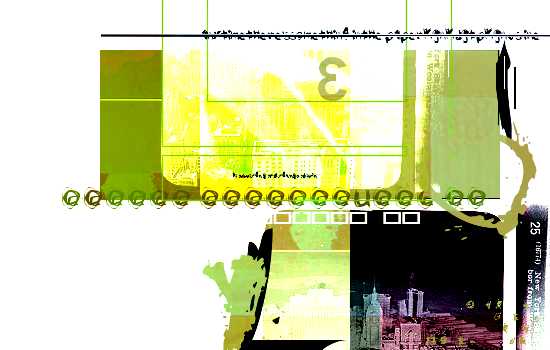
|
 T R O P I C A L S
T R O P I C A L S
 Most of Florida is wedged in a horticultural No-Man's-Land, caught between Temperate and Tropical. It's not the long growing season which makes the difference. Just as the scant chilling time which prevents us from growing Spruces and Spring Bulbs; it's the few hours of cold per year our gardens may experience that drastically decides what Jungles we can grow or not grow. Some tropical plants experience a dry or dormant season in their native lands, some tropical come from high altitudes which are exposed to cold; these beauties adadpt well to our climate. Of course the undying efforts and trials of Horticulturists and Nurserymen constantly expand our choices.
Most of Florida is wedged in a horticultural No-Man's-Land, caught between Temperate and Tropical. It's not the long growing season which makes the difference. Just as the scant chilling time which prevents us from growing Spruces and Spring Bulbs; it's the few hours of cold per year our gardens may experience that drastically decides what Jungles we can grow or not grow. Some tropical plants experience a dry or dormant season in their native lands, some tropical come from high altitudes which are exposed to cold; these beauties adadpt well to our climate. Of course the undying efforts and trials of Horticulturists and Nurserymen constantly expand our choices.

BIRD NEST FERNS
Asplenium nidus
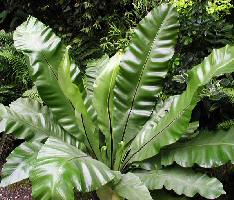
 This Southeast Asian plant screams Tropical Rainforest. The wide, almost glowing green fronds and tentacle-like new growth which uncurl from it's central growing point make it seem creature-like. Our Central Florida climate is well suited for this fern, being able to handle short durations of cold without problems. All this baby needs is a wind sheltered place under a tree: the shade and leaf litter provided takes care of it's needs. Though it may look like it needs constant water, this is not the case. If you meet it's conditions, you can have a head-turning, five foot high and wide plant in a few years!
This Southeast Asian plant screams Tropical Rainforest. The wide, almost glowing green fronds and tentacle-like new growth which uncurl from it's central growing point make it seem creature-like. Our Central Florida climate is well suited for this fern, being able to handle short durations of cold without problems. All this baby needs is a wind sheltered place under a tree: the shade and leaf litter provided takes care of it's needs. Though it may look like it needs constant water, this is not the case. If you meet it's conditions, you can have a head-turning, five foot high and wide plant in a few years!
HIBISCUS
Hibiscus roseo-sinensis hybrids
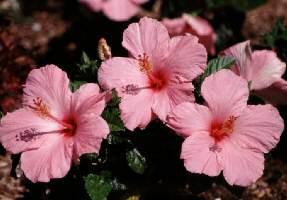
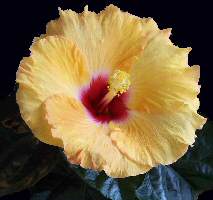
 It's no wonder that Hibiscus are grown all across the globe, not just in warm areas. The enormous blooms last only a day, yet are constantly produced by the plants. Breeders ensure that there are constant new color varieties. Easily grown in most conditions, it's only need seems to be plenty of sun, to guarantee the most blossoms possible. These performers jump right back after any occasional cold damage.
It's no wonder that Hibiscus are grown all across the globe, not just in warm areas. The enormous blooms last only a day, yet are constantly produced by the plants. Breeders ensure that there are constant new color varieties. Easily grown in most conditions, it's only need seems to be plenty of sun, to guarantee the most blossoms possible. These performers jump right back after any occasional cold damage.
VARIEGATED GINGER
Alpinia zerumbet 'Varigata'
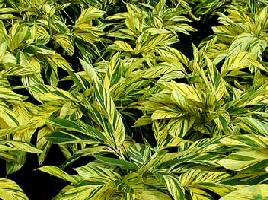
 With any kind of irrigation this Ginger will thrive. Perfect for that gloomy corner of a garden, the bright yellow stiped foilage even makes it's beautiful, exotic shell-like ivory and yellow colored flowers take a back seat.
With any kind of irrigation this Ginger will thrive. Perfect for that gloomy corner of a garden, the bright yellow stiped foilage even makes it's beautiful, exotic shell-like ivory and yellow colored flowers take a back seat.
WHITE BIRD OF PARADISE
Strelitzia nicolai
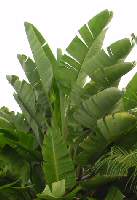
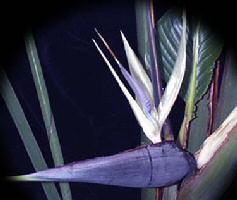
 The huge sculpturesque leaves of this herbraceous tree are eye-catching, even from a distance. The bonus of this tropical plant are the large, very exotic blue and white flowers. It looks best in a wind-protected site, to avoid tattering of it's leaves and being truly tropical, deserves a warm spot. Planting next to a wall meets these needs, and at the same time shows off it's form best.
The huge sculpturesque leaves of this herbraceous tree are eye-catching, even from a distance. The bonus of this tropical plant are the large, very exotic blue and white flowers. It looks best in a wind-protected site, to avoid tattering of it's leaves and being truly tropical, deserves a warm spot. Planting next to a wall meets these needs, and at the same time shows off it's form best.
MONSTERA
Monstera deliciosa
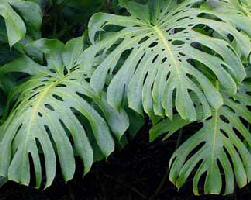
 Turn your Trees into the Amazon Basin! There is no plant that matches the feel that this treeclinger imparts. Its architectual leaves become more massive and lush coresponding to the omount of moisture the plants recieve. It grows slowly but surely up fissured barks, each leaf an artistic tableau, but never causes any harm to it's support, unlike Synogium.
Turn your Trees into the Amazon Basin! There is no plant that matches the feel that this treeclinger imparts. Its architectual leaves become more massive and lush coresponding to the omount of moisture the plants recieve. It grows slowly but surely up fissured barks, each leaf an artistic tableau, but never causes any harm to it's support, unlike Synogium.
TI PLANT
Cordyline terminalis
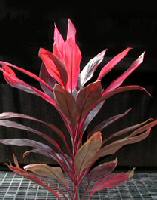
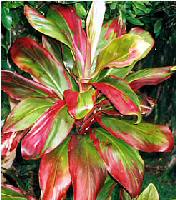
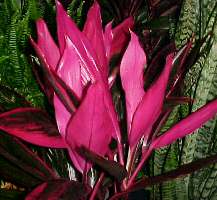
 The Ti Plant was brought to Hawaii by early Polynesians as a utilitarian plant, but now it is enjoyed throughout the warmer regions of the world because of the outrageous colors of the foilage. Ultratropical in appearance, this plant has known to commonly resprout after being exposed to subfreezing temperatures.
The Ti Plant was brought to Hawaii by early Polynesians as a utilitarian plant, but now it is enjoyed throughout the warmer regions of the world because of the outrageous colors of the foilage. Ultratropical in appearance, this plant has known to commonly resprout after being exposed to subfreezing temperatures.
PRINCESS FLOWER
Tibochina sp.
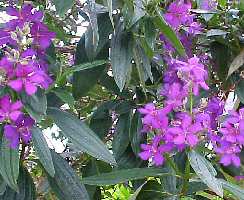
 Brilliant purple flowers sporadically grace this tropical shrub. Several species, differing in leaf form and growth height are commonly available to Central Florida growers.
Brilliant purple flowers sporadically grace this tropical shrub. Several species, differing in leaf form and growth height are commonly available to Central Florida growers.
PHILODENDRONS
Philodendron cultivars
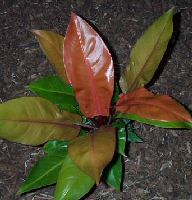
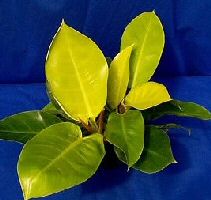
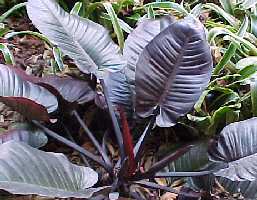
 Recent Philodendron hybrids are the epitomy of form and color. Due to the non-vining traits, these elegant plants stay put wherever they're placed, only growing fuller with time. The foilage color is more intense in newer growth, so you can have several shades of color on the same plant. Due to the modest sizes, they can easily be protected on those rare freezing nights. Perfect for containers and poolsides, or anywhere a bold tropical touch is needed.
Recent Philodendron hybrids are the epitomy of form and color. Due to the non-vining traits, these elegant plants stay put wherever they're placed, only growing fuller with time. The foilage color is more intense in newer growth, so you can have several shades of color on the same plant. Due to the modest sizes, they can easily be protected on those rare freezing nights. Perfect for containers and poolsides, or anywhere a bold tropical touch is needed.
BANGKOK ROSE
Mussaenda erythrophylla
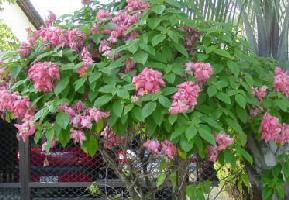
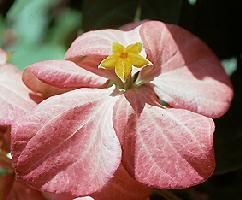
 This sprawling woody shrub can reach up tp 15 feet, but in Central Florida it rarely grows that tall. Its thick, felt-like flower bracts, which range from white, pink to red, are the most stunning feature of this plant. Since the branches become somewhat bare during our Winters, this plant is best used incorporated with other foilage, yet as soon as warm weather approaches, it leafs out and blossoms as if Janurary never existed, thriving in our heat and humidity.
This sprawling woody shrub can reach up tp 15 feet, but in Central Florida it rarely grows that tall. Its thick, felt-like flower bracts, which range from white, pink to red, are the most stunning feature of this plant. Since the branches become somewhat bare during our Winters, this plant is best used incorporated with other foilage, yet as soon as warm weather approaches, it leafs out and blossoms as if Janurary never existed, thriving in our heat and humidity.
BROMELIADS
Bromeliad hybrids
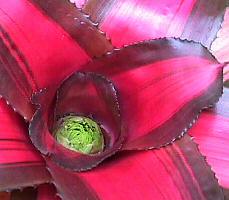
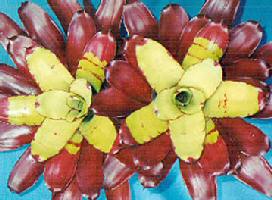
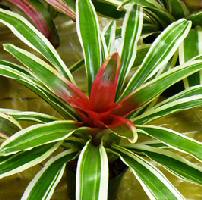
 Thousands of Bromeliad hybrids are suited for the homescape. Their perfect geometric form and insane combinations of colors give a splash of tropics wherever they are placed; thriving on the ground or mounted on trees. When those rare freezes loom, bromeliads can be easily covered or literally ripped up from the ground and brought into the home, chasing away those Wintertime Blues. Our favorite is 'Fireball', a vigorous dwarfish beauty that spreads by a constant production of pups. Good news; it has been recently proved that mosquito larvae are NOT hosted in the water that bromeliads hold.
Thousands of Bromeliad hybrids are suited for the homescape. Their perfect geometric form and insane combinations of colors give a splash of tropics wherever they are placed; thriving on the ground or mounted on trees. When those rare freezes loom, bromeliads can be easily covered or literally ripped up from the ground and brought into the home, chasing away those Wintertime Blues. Our favorite is 'Fireball', a vigorous dwarfish beauty that spreads by a constant production of pups. Good news; it has been recently proved that mosquito larvae are NOT hosted in the water that bromeliads hold.
|



















